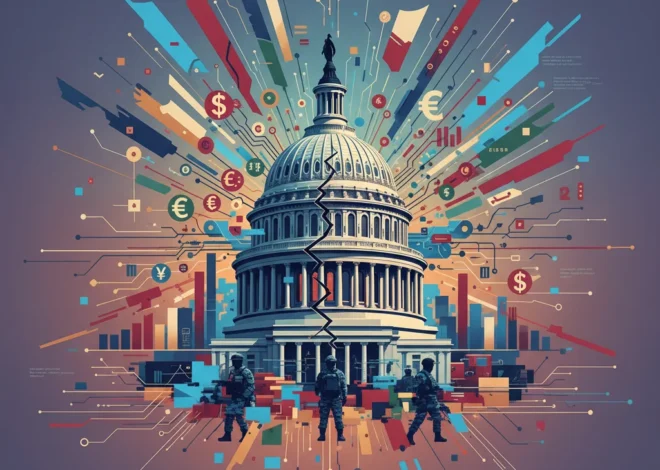
The Cicero Strategy: Why Political Silence on the Economy is the Loudest Signal for Investors
In the high-stakes world of politics and finance, what isn’t said is often more important than what is. This isn’t a modern phenomenon born from 24-hour news cycles; it’s an ancient strategy, a delicate dance of ambiguity designed to navigate treacherous political waters. A recent letter to the Financial Times by Jack William Byers brilliantly connected the dots across millennia, linking the rhetorical tactics of Roman orator Cicero to the campaign of George H.W. Bush and the modern economic pronouncements of UK’s Shadow Chancellor, Rachel Reeves. The core idea? The “promise not to promise.”
This strategy of calculated vagueness on critical economic issues—from taxes to spending—is a powerful political tool. But for investors, business leaders, and anyone with a stake in the economy, it’s a flashing red light of uncertainty. In an era where algorithms execute trades in microseconds based on sentiment analysis, this ancient political art form has profound and immediate consequences for the stock market, banking, and the future of financial technology.
This article delves into the “Cicero Strategy,” exploring its historical roots, its modern applications, and, most importantly, what it means for your investment portfolio and business strategy in today’s hyper-connected financial world.
A Timeless Tactic: From Roman Land Reform to Modern Tax Debates
To understand the present, we must look to the past. The strategy of non-commitment is not a sign of weakness but often a calculated display of political acumen, designed to hold together broad, often contradictory, coalitions.
The original letter writer points to Cicero, who, when pressed on his policy for land reform—a deeply divisive issue in the Roman Republic—responded that his policy was to say nothing at all. As one of the most explosive topics of his time, any firm stance would have alienated either the wealthy land-owning aristocracy or the populist faction demanding redistribution. By remaining silent, Cicero preserved his political capital. It was a masterclass in navigating a no-win situation.
Fast forward two thousand years to the 1988 U.S. presidential election. Campaign manager Lee Atwater famously advised of his candidate, George H.W. Bush, “the less he says, the better he does.” While Bush ultimately ignored this advice with his fateful “Read my lips: no new taxes” pledge—a promise he was later forced to break, costing him dearly in his 1992 re-election bid—the initial strategy was rooted in the same logic. Specific economic promises are political landmines. They create rigid expectations that are difficult to meet when the complex realities of governing the national economy set in.
This brings us to the contemporary example of UK Shadow Chancellor Rachel Reeves, who stated she has “no plans that require tax rises.” This is a carefully constructed phrase. It is not a promise to never raise taxes. It is a conditional statement that leaves immense room for maneuver. If unforeseen circumstances “require” a change, the promise remains technically unbroken. It’s a classic example of the promise not to promise, designed to reassure voters and markets without being boxed in.
Hollywood's New Kingmakers: Inside the Saudi-Backed Bid to Forge a Media Supergiant
Why Markets Despise a Vacuum: The Price of Uncertainty
While strategic ambiguity may be a political necessity, it is poison for financial markets. Investing is fundamentally about pricing future risk and opportunity. When the future policy landscape is deliberately obscured, risk skyrockets.
This “political risk” manifests in several ways:
- Increased Volatility: Uncertainty leads to speculation. Traders and investment funds will make opposing bets on the eventual outcome, causing wild swings in the stock market and currency values.
- Delayed Investment: Business leaders hate uncertainty more than bad news. A clear (even if unfavorable) tax or regulatory regime allows for planning. Ambiguity, however, forces companies to pause hiring, delay capital expenditures, and hoard cash until the picture becomes clearer. This can lead to economic stagnation.
- Risk Premiums: Investors demand higher returns for taking on higher risk. When a country’s economic direction is unclear, the yields on its government bonds may rise as investors demand a premium. This increases the government’s borrowing costs, creating a vicious cycle that can further constrain the economy.
To illustrate how markets interpret political language, consider the potential impact of different types of statements on key sectors.
| Type of Political Statement | Hypothetical Example | Potential Impact on Stock Market/Economy |
|---|---|---|
| The Specific, Hard Promise | “We will implement a 5% windfall tax on all energy companies.” | Immediate, sharp decline in energy sector stocks. Potential for reduced investment in domestic energy production over the long term. |
| The Aspirational Goal | “Our goal is to become a world leader in green technology.” | Moderate, positive momentum for renewable energy and EV stocks. Market waits for concrete policy and funding details. |
| The Strategic Ambiguity (Cicero Strategy) | “We have no current plans for new taxes, but we will ensure corporations pay their fair share.” | Heightened volatility across all sectors, especially banking and large-cap stocks. Investors parse every word for clues, leading to short-term market jitters and higher trading volumes. |
| The Direct Reversal | “Due to new economic data, we must now consider raising corporate taxes.” | Sharp, broad-based market sell-off. Erodes investor confidence and political credibility, potentially leading to a sustained downturn. |
The Fintech Factor: How Technology is Rewriting the Rules
The dynamic between political speech and market reaction is being supercharged by financial technology. The game is no longer just played by human analysts poring over budget documents; it’s being fought on the digital frontier.
Sophisticated `fintech` platforms now employ Natural Language Processing (NLP) and AI-driven sentiment analysis to scan political speeches, press releases, and even social media posts in real-time. These systems are programmed to detect subtle shifts in tone, keyword frequency, and deviations from previous statements. A politician might think they are being cleverly ambiguous, but an algorithm might interpret that ambiguity as a quantifiable increase in risk, triggering automated `trading` strategies.
This creates a feedback loop. Politicians must be more careful than ever with their language, knowing that a single poorly chosen word can be amplified into a market-moving event by technology. This new reality has massive implications for the `banking` and `investing` industries, which must now model for a new kind of hyper-volatile political risk.
Could technology also offer a solution? Some futurists in the `blockchain` space argue for radical transparency. Imagine a government where major spending commitments and tax receipts were recorded on a distributed, immutable ledger. This could, in theory, reduce the need for trust in political promises by making fiscal realities publicly verifiable. While a long way from implementation, it highlights how `financial technology` is not just reacting to the old rules but is actively creating a new paradigm of transparency and accountability that clashes directly with the ancient art of political ambiguity.
The Trillion-Dollar Handshake: Decoding the High-Stakes Intersection of Geopolitics and Finance
Navigating the Fog: A Guide for Investors and Leaders
So, how should one navigate an `economics` landscape shrouded in deliberate fog? Acknowledging the uncertainty is the first step. The second is to build a robust strategy that can withstand political shocks.
- Diversify, Diversify, Diversify: This is the oldest advice in the book for a reason. A well-diversified portfolio across different asset classes, sectors, and geographies is the most effective hedge against the policy whims of any single government.
- Focus on Fundamentals: Political noise creates short-term volatility. Strong companies with solid balance sheets, sustainable cash flow, and a durable competitive advantage tend to perform well over the long term, regardless of the political climate. Use periods of market panic to acquire quality assets at a discount.
- Analyze the Direction, Not the Detail: Instead of obsessing over specific promises, analyze the broader ideological “direction of travel.” Is the political trend towards more regulation or deregulation? Higher or lower taxes? Increased or decreased public spending? These macro trends are often more predictive than specific, and often breakable, promises.
- Scenario Planning for Businesses: For business leaders, this means stress-testing your business model against multiple potential policy outcomes. What would a 5% increase in corporate tax do to your profitability? How would new environmental regulations impact your supply chain? Having a plan for various scenarios is crucial for resilience.
Conclusion: An Ancient Game with Modern Stakes
The line drawn from Cicero’s Rome to the modern corridors of power is a stark reminder that while technology and markets have evolved, human political nature has not. The “promise not to promise” is a survival tactic for politicians, but it creates a dangerous vacuum for the global economy. In this void, fear and speculation thrive, and capital remains on the sidelines.
For those of us in the world of `finance`, `investing`, and business, the key is not to try and predict the unpredictable. It is to understand the game being played. By recognizing strategic silence for what it is—a signal of underlying conflict and future uncertainty—we can build strategies that are not dependent on promises but are resilient in their absence. In the end, the loudest message the market hears is not the carefully crafted statement, but the deafening silence that follows.


